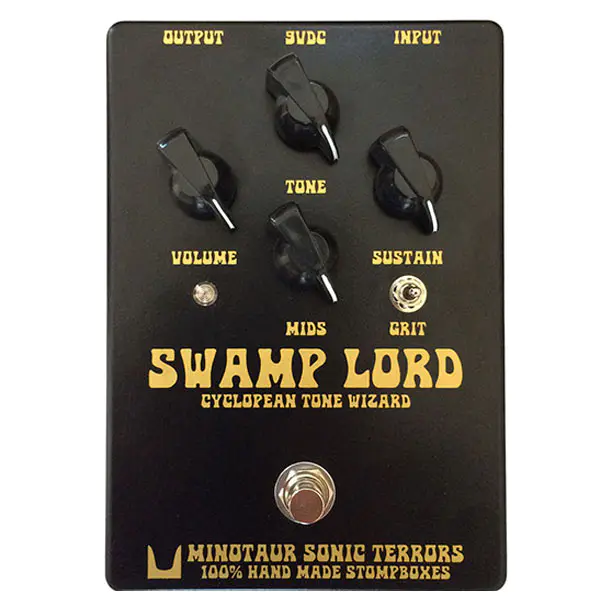
A variant of the Electro Harmonix V2 Big Muff Pi “Ram’s Head” (1973-1977), the Minotaur Sonic Terrors Swamp Lord is a pedal that can deliver a wide variety of dirty tones, beyond fuzz.
Sporting the same carbon resistors and four selected NOS BC239C transistors found in the original, the Swamp Lord features updates that deliver a clearer tone, and a Mids knob that allows overcoming the Big Muff’s notorious lack of mids – which can also be used for an even more scooped tone.
A Grit toggle switch provides three different clipping modes:
Bottom position: silicon clipping like in the original.
Middle position: the bassier of the three settings and also the one with more sustain.
Upper position: asymmetrical clipping using both silicon and germanium diodes for a more “open” tone with a bit less gain and compression. This mode widens this pedal’s sonic palette, allowing for tones closer to overdrive and distortion with a character reminiscent of the sounds used in the records from the ’70s.
Check out the demos!
Minotaur Sonic Terrors Swamp Lord, Builder’s Notes
The Swamp Lord is an extremely versatile pedal that can cover all your dirt pedal needs. As you can listen on the demo video, you can go from ultra heavy/sludgy tones to 70s overdriven tones and everything in between. By using all controls and especially our mids and grit controls, you will find that you can make it sound as a fuzz, or you can tighten it up and make it sound more like a distortion or even an overdrive pedal.
Using a bigger enclosure this time to remind the luxurious pedals of old, it is a redesigned version of the very sought after first version Electro Harmonix V2 Big Muff Pi “Ram’s Head” (1973-1977), made famous by David Gilmour of Pink Floyd, J. Mascis of Dinosaur Jr and countless more. We have updated the original design providing a clear tone with less hiss and high articulation for a high gain pedal such as this. Staying true to the original, we have used carbon composition resistors and four gain selected NOS BC239C transistors.
Of course these are not the only differences to the original. Most people have issues using big muff pedals in studio situations, due to their lack of midrange. We overcame this by adding a “MIDS” control where you can increase or scoop the midrange according to your liking or recording needs. It helps your tone breathe more and stand out in all studio or live situations.
We are currently also offering a smaller, more pedalboard friendly version of the Swamp Lord, housed in a 120mm X 95mm enclosure as seen bellow. All materials and tone are the same, the only thing different is the size of the pedal.
CONTROLS
The Swamp Lord is probably the most versatile pedal we have built up to date. Apart from the mids control, we have added the “GRIT” switch. It is a 3 position switch that alters the clipping method of the effect.
On the bottom position, you have silicon clipping with which you get the original Ram’s Head tones. By having the grit at the bottom position and the mids control at around 1 to 2 o’clock you get that true 70s Ram’s Head tone.
The grit switch in the middle position will probably become a bass player’s favourite. The tone and bass response become huge! You can listen to the tone at the 04:13 of the demo video. A no tricks massive and endless sustain that will satisfy even the most demanding player.
The grit switch in the upper position provides asymmetrical clipping using both silicon and germanium diodes. This combination produces a more “open” tone with a bit less gain and compression, and with a more overdrive-ish character. You will find this perfect for vintage rock as the overall character and gain has a more 70s feel to it.
To sum it all up, the Swamp Lord is an extremely versatile pedal. You can nearly get all dirt tones you can imagine combining all its features.
The rest of the controls, Volume, Tone and Sustain are pretty straight-forward and do what you expect them to do. The volume knob controls the volume of the effect, the sustain control controls the gain, and the tone control is the classic big muff tone control that increases the low frequencies when you turn in counter-clockwise and increases the treble response when you turn it clockwise.






















